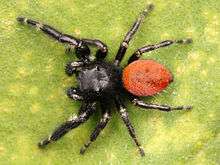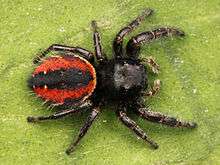Phidippus johnsoni
| Red-backed jumping spider | |
|---|---|
 | |
| Male | |
 | |
| Female | |
| Scientific classification | |
| Kingdom: | Animalia |
| Phylum: | Arthropod |
| Class: | Arachnida |
| Order: | Araneae |
| Suborder: | Araneomorphae |
| Family: | Salticidae |
| Genus: | Phidippus |
| Species: | P. johnsoni |
| Binomial name | |
| Phidippus johnsoni (Peckham & Peckham, 1883) | |
| Synonyms | |
| |
The red-backed jumping spider (Phidippus johnsoni) is one of the largest and most commonly encountered jumping spiders of western North America. It is not to be confused with the unrelated and highly venomous redback spider (Latrodectus hasselti).
Description
Adults tend to be about a centimeter in length. Both sexes have a bright red abdomen; the female has in addition a black central stripe. The chelicerae of both sexes are of a shining teal color. The rest of the body is mostly black. It is one of the species of jumping spiders that are mimics of mutillid wasps in the genus Dasymutilla (commonly known as "velvet ants"); several species of these wasps are similar in size and coloration, and possess a very painful sting.[1]
Distribution
The distribution of P. johnsoni is bounded by the Great Plains, the Pacific Ocean, northern Mexico and southern Canada. It occurs from sea level to tree line, occupying relatively dry habitats such as coastal dunes or oak woodlands. Between two and thirty redback jumping spiders per 1,000 m² were found during a study in 1976.
In 2012, NASA sent an individual of this species into space.[2]
Habits
This species constructs conspicuous tubular silken nests under rocks and wood on the ground and sometimes grape vines. They remain inside these at night and during bad weather. Molting, egg laying and sometimes courtship and mating occur inside these nests. Most of the time they feed on prey about half their own size, but a range from 2 millimetres (0.079 in) to about 1 centimetre (0.39 in) has been observed. Although found to feed on a wide variety of insects (e.g., flies, bugs and moth caterpillars and adults), they also prey heavily on spiders. Cannibalism does occur from time to time, in the form of females feeding on males.
References
- ↑ Richman, D.B. "Flea beetle mimicry in jumping spiders - a review.". Retrieved 2009-01-19.
- ↑ http://www.nasa.gov/mission_pages/station/research/news/spidernaut.html
- Peckham, G. W. & E. G. Peckham (1883). Descriptions of new or little known spiders of the family Attidae from various parts of the United States of North America. Milwaukee, pp. 1–35.
- Jackson, R.R. (1977). Prey of the jumping spider Phidippus johnsoni (Araneae: Salticidae). J. Arachnol. 5:145-149. PDF
- Jackson, R.R. (1978). The life history of Phidippus johnsoni (Araneae: Salticidae). J. Arachnol. 6:1-29. PDF
External links
| Wikimedia Commons has media related to Phidippus johnsoni. |
- Pictures and description (with pictures of mating dance)